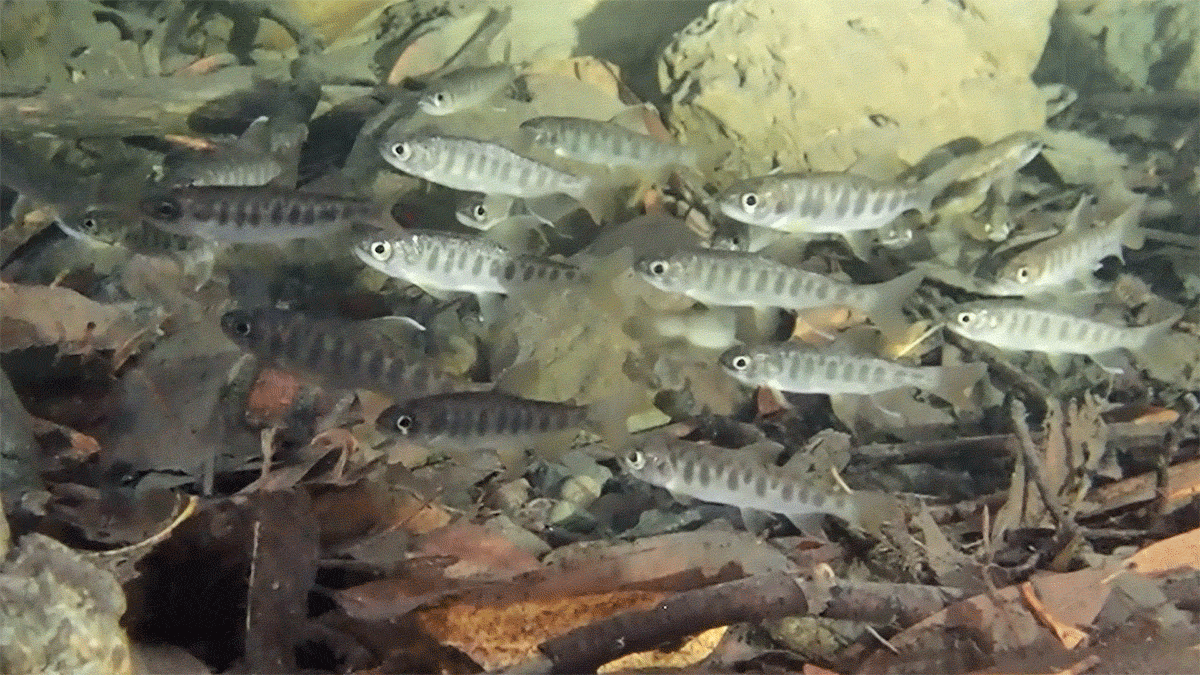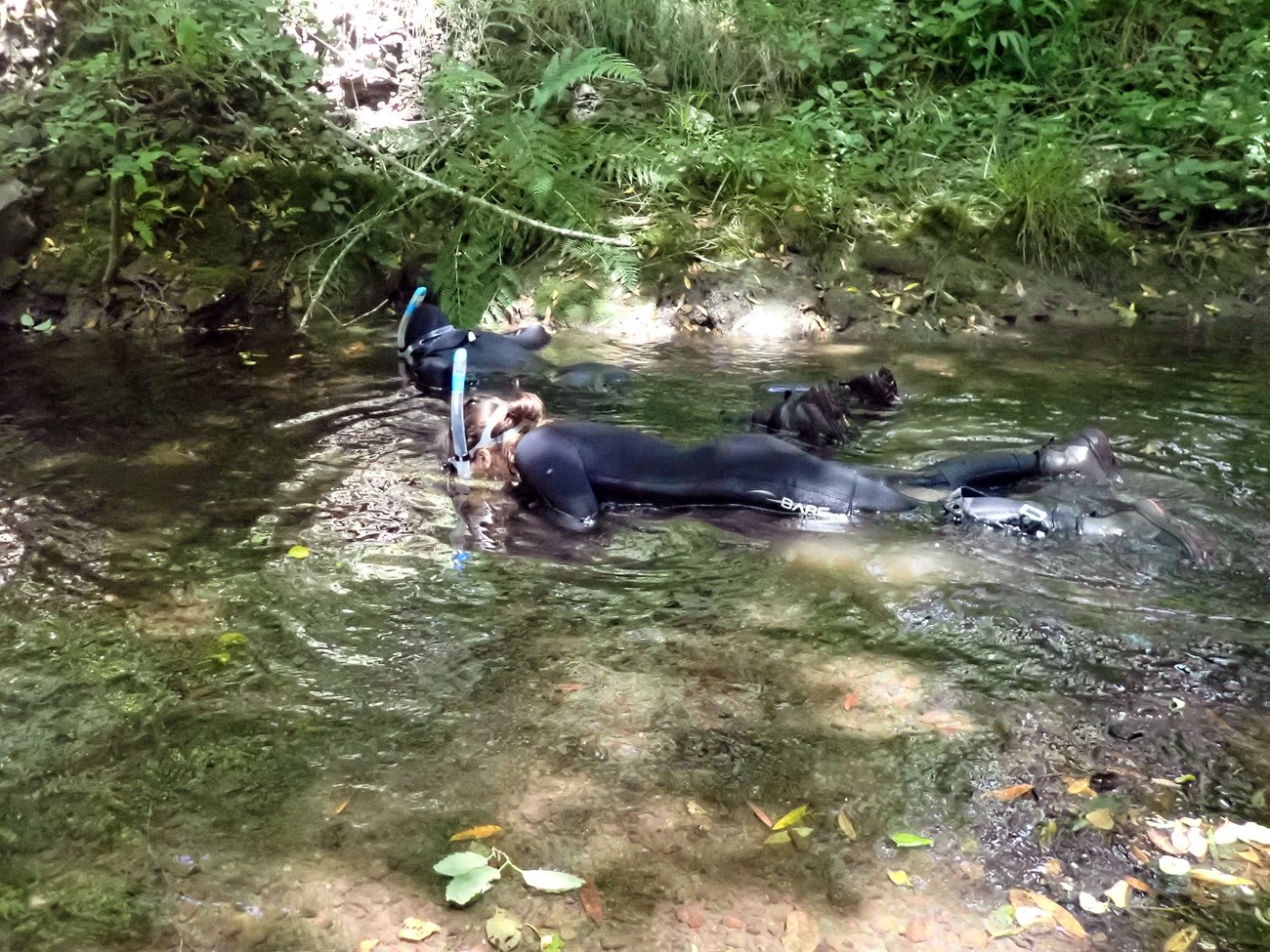Last updated: August 14, 2025
Article
Summer 2024 a Good Season for Bay Area Coho

NPS
November 2024 - Each summer, the San Francisco Bay Area Network (SFAN) fisheries crew spends a majority of its time in three Marin County, CA streams: Olema Creek, Pine Gulch Creek, and Redwood Creek, monitoring juvenile coho and steelhead populations. After completing our summer 2024 surveys, we found that it was a decent year for juvenile coho!
Summer sampling is a dance between three key activities: habitat-typing, snorkel surveys, and electrofishing surveys. When habitat-typing (the term we use for documenting the location and extent of different kinds of stream habitat), low water levels can be helpful. They allow us to easily discern breaks in the stream habitat and document the number of habitat types including pools, flatwaters, and riffles. We are most interested in pool habitat, because it’s where young coho are likely hanging out.

NPS
During habitat surveys, we tie flags at the downstream and upstream ends of a subset of the pools we find to mark these areas for snorkeling. The water is cold and often dark, so the snorkelers go in with wetsuits and dive lights, and as they move their way through each pool, they count juvenile coho and steelhead. Snorkelers also note three-spined stickleback, sculpin, roach, freshwater shrimp, California giant salamanders, California newts, red-legged frogs, and any other aquatic creatures they happen to see.

NPS
This way of counting fish can yield different results based on the size and experience of the snorkel crew, visibility, and pool complexity. Because of this, we use electrofishing to calibrate snorkel counts. The electrofisher wields a battery-powered backpack attached to a wand that delivers a small amount of electricity to the creek within ~1 foot of the wand end. The e-fisher is flanked on each side by a netter who, when prompted by the flash of a stunned fish’s belly, swoops their net through the water to capture the fish. They need to be quick, since the fish are only stunned momentarily. Other crew members measure and weigh fish as they are captured. If it’s a coho, they might also give it a passive integrated transponder (PIT) tag by using a scalpel to insert the tag into the fish’s abdomen. We can then track the tagged fish with channel-spanning antennas as they move out of the stream as smolts.
This year, we increased our summer tagging efforts in Redwood and Olema Creeks to improve smolt monitoring and to get a better picture of fine-scale juvenile movements over the winter. These efforts resulted in almost 400 wild coho tagged on Olema Creek and over 80 coho on Redwood Creek, which will help us achieve more informed monitoring throughout all salmonid life-stages.

NPS
With habitat-typing, snorkel counts, and electrofishing complete, our estimates suggest that Redwood Creek contained fewer juvenile coho than we would have hoped after documenting multiple redds, or nest sites, during the winter. Pine Gulch Creek surprised us with low juvenile numbers, but more than expected given that no coho juveniles were observed between 2010 and 2020. As for Olema Creek, the largest coho-bearing creek we monitor, we estimated roughly 20,000 juveniles this summer. Although coho numbers fluctuate highly from year to year, the 2024 estimate for Olema Creek will be one of the highest in the last decade. That's an encouraging sign for the species' recovery!
We hope to see most of these fish again come spring 2025 as we monitor them on their way out to the ocean as smolts. Our further hope is that coho numbers begin rising more consistently across all cohorts and creeks. But for now, we're grateful for a successful summer season and are looking forward to the upcoming spawner season, which we expect to be very busy!
For more information
- San Francisco Bay Area Network Salmonid Monitoring webpage
- Pacific Coast Science & Learning Center Coho & Steelhead webpage
- Contact Fishery Biologist Michael Reichmuth
See more from the Bay Area Nature & Science Blog
Tags
- golden gate national recreation area
- muir woods national monument
- point reyes national seashore
- sfan
- blog
- fish
- threatened and endangered species
- salmonids
- coho salmon
- steelhead trout
- juveniles
- monitoring
- snorkeling
- electrofishing
- marin county
- california
- redwood creek
- olema creek
- pine gulch creek
- brooke harvey
- seasonal update
